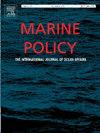Seismic surveys and the role of scientific advice in Norway
IF 3.7
2区 社会学
Q2 ENVIRONMENTAL STUDIES
引用次数: 0
Abstract
Geophysical surveys using airguns are used for both oil and gas exploration and site assessments for offshore wind development. These airguns generate intense sound which may disturb marine mammals and fish. Norwegian petroleum resources are located on the continental shelf, with ∼60–80 seismic surveys annually. These same waters are crucial spawning grounds for numerous fish populations, support a diverse marine mammal community, and underpin many fisheries. Consequently, effective management practices are essential to minimize wildlife impact. Norwegian regulators seek scientific advice from the Institute of Marine Research (IMR) regarding such potential impacts. We present the scientifically based management advice, which is accepted and followed by regulators. The basis of this advisory strategy is that critical habitats and periods are evaluated and published as “advisory maps” of areas where it is advised to avoid seismic surveys; with each map representing a 2-week period of the year. The dataset is updated annually, considering new scientific knowledge about disturbance from sound, as well as updated knowledge about distribution of animals and critical habitats such as spawning grounds. Maps are included in the application procedure for seismic surveys, ensuring that the scientific advice is followed by the industry.
挪威的地震调查和科学建议的作用
使用气枪的地球物理测量既用于石油和天然气勘探,也用于海上风电开发的现场评估。这些气枪产生强烈的声音,可能会干扰海洋哺乳动物和鱼类。挪威的石油资源位于大陆架上,每年进行约60-80次地震调查。这些水域是众多鱼类的重要产卵地,支持着多样化的海洋哺乳动物群落,并支撑着许多渔业。因此,有效的管理措施对于尽量减少对野生动物的影响至关重要。挪威监管机构就此类潜在影响向海洋研究所(IMR)征求科学建议。我们提出了科学的管理建议,为监管机构所接受和遵循。这一咨询战略的基础是对关键生境和时期进行评估并作为建议避免地震调查的地区的“咨询地图”出版;每张地图代表一年中的两个星期。该数据集每年更新一次,考虑到有关声音干扰的新科学知识,以及有关动物分布和产卵地等关键栖息地的最新知识。地震勘测的申请程序中包括地图,以确保行业遵循科学建议。
本文章由计算机程序翻译,如有差异,请以英文原文为准。
求助全文
约1分钟内获得全文
求助全文
来源期刊

Marine Policy
Multiple-
CiteScore
7.60
自引率
13.20%
发文量
428
期刊介绍:
Marine Policy is the leading journal of ocean policy studies. It offers researchers, analysts and policy makers a unique combination of analyses in the principal social science disciplines relevant to the formulation of marine policy. Major articles are contributed by specialists in marine affairs, including marine economists and marine resource managers, political scientists, marine scientists, international lawyers, geographers and anthropologists. Drawing on their expertise and research, the journal covers: international, regional and national marine policies; institutional arrangements for the management and regulation of marine activities, including fisheries and shipping; conflict resolution; marine pollution and environment; conservation and use of marine resources. Regular features of Marine Policy include research reports, conference reports and reports on current developments to keep readers up-to-date with the latest developments and research in ocean affairs.
 求助内容:
求助内容: 应助结果提醒方式:
应助结果提醒方式:


